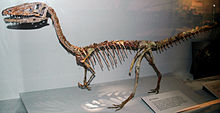
Back Coelophysoidea Afrikaans سيلوفايسيات Arabic Selofizoidlər Azerbaijani Coelophysoidea Breton Celofisoïdeus Catalan Coelophysoidea CEB Coelophysoidea Czech Coelophysoidea German Coelophysoidea Spanish Coelophysoidea Basque
| Coelophysoids Temporal range: Late Triassic-Early Jurassic,
| |
|---|---|

| |
| Mounted skeleton of Coelophysis bauri, Cleveland Museum of Natural History | |
| Scientific classification | |
| Domain: | Eukaryota |
| Kingdom: | Animalia |
| Phylum: | Chordata |
| Clade: | Dinosauria |
| Clade: | Saurischia |
| Clade: | Theropoda |
| Clade: | Neotheropoda |
| Superfamily: | †Coelophysoidea Nopcsa, 1928 |
| Type species | |
| †Coelophysis bauri Cope, 1887
| |
| Subgroups | |
| |
| Synonyms | |
| |
Coelophysoidea is an extinct clade of theropod dinosaurs common during the Late Triassic and Early Jurassic periods. They were widespread geographically, probably living on all continents. Coelophysoids were all slender, carnivorous forms with a superficial similarity to the coelurosaurs, with which they were formerly classified, and some species had delicate cranial crests. Sizes range from about 1 to 6 m in length. It is unknown what kind of external covering coelophysoids had, and various artists have portrayed them as either scaly or feathered. Some species may have lived in packs, as inferred from sites where numerous individuals have been found together.
Examples of coelophysoids include Coelophysis, Procompsognathus and Liliensternus. Most dinosaurs formerly referred to as being in the dubious taxon "Podokesauridae" are now classified as coelophysoids. The family Coelophysidae, which is contained within Coelophysoidea, flourished in the Late Triassic and Early Jurassic periods, and has been found on numerous continents. Many members of Coelophysidae are characterized by long, slender skulls and light skeletons built for speed.[1] One member genus, Coelophysis, displays the earliest known furcula in a dinosaur.[2]
- ^ Hendrickx, C.; Hartman, S.A.; Mateus, O. (2015). "An overview of non-avian theropod discoveries and classification". PalArch's Journal of Vertebrate Paleontology. 12 (1): 1–73. ISSN 1567-2158.
- ^ Rinehart, L.F.; Lucas, S.G.; Hunt, A.P. (2007). "Furculae in the Late Triassic theropod dinosaur Coelophysis bauri". Paläontologische Zeitschrift. 81 (2): 174–180. doi:10.1007/BF02988391.